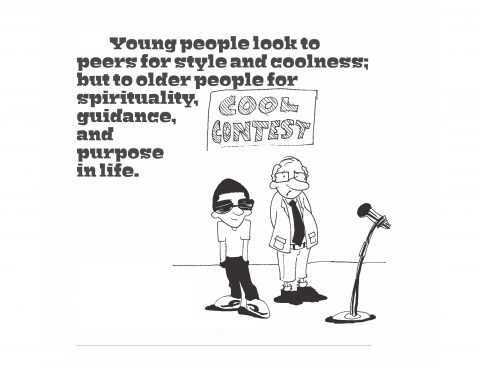Overview
Enoch’s very close walk with God on earth continues because God already took him to heaven.
Read the Student Lesson as well as the Teacher’s Guide. This may provide everything you need to teach the Youth Sabbath School lesson.
Following are additional components that you can pick and choose, use “as is” or adapt to your specific Youth Sabbath School. These supplemental ideas provide more options for this topic. Here’s a brief description of the seven supplemental materials:
And here are those seven supplemental materials in more detail for this week’s lesson: “A Very Long Walk With God”.

An icebreaker or something to get people focused as you begin.
OPTION 1: “GIVE ME TIME”
How long do people live? It depends on what part of the world, whether or not there is an accident or disease, their genetics, and their lifestyle. In Bible times, life expectancy was 70-80 years (Psalm 90:10). Today, it might not be much different. In today’s Scripture passage, we read the age span of people before the Flood. Many of them lived for more than 900 years. That’s way beyond our imagination. Jared had a son at the age of 162 (Genesis 5:18).
With the list provided, place the various animals where they belong on the lifeline, from those who, on the average, live the shortest to those who live the longest. These numbers were taken from the internet. Your experience may differ from the average.
Give each participant a copy of the “Give Me Time” sheet. Have them work alone, and then have them work in groups or as one group. Compare individual and group answers to the key you provide. The answers are from general searches on the internet. Individual exceptions are to be expected. These are simply averages.
OPTION 2: "LINE UP"
Have everyone in your group line up on a line. If you have no line on the floor, simply put down a strip of masking tape so each person can stand on the line/tape, standing shoulder- to-shoulder. If you have a small group of only one person plus you, recruit a few people from the hallway to join you. If you have a large group of more than 10 people, divide into smaller groups with no more than 10 people in a group and make it a time competition.
With everyone lined up, have them number from one end to the other, starting with 1 and continuing with 2, 3, etc., to the last person. Then, always keeping at least one foot on the line/tape, reverse the order of your line so number 1 is at the opposite end of the line. This will take some close connections and stepping over or under or slipping by while keeping at least one foot on the line/tape at all times. You can create your own rules if someone cheats, such as returning everyone to their original position and starting over, or just having the person who cheated move to the end or do it over.
TRANSITION: As we consider our topic for today: “A Very Long Walk With God,” we’ll consider both the issue of time (“very long”) and what it means to be close to God (“walk with God”).

Create a video clip that illustrates what a very long walk with God might include. Ask someone in advance to create follow up questions based on these video clips.
You can opt to use the following YouTube video clip “Discipline” by iBelieveBible (about 2 1/2 minutes) and the follow-up questions provided (or create your own questions for “Discipline”):
www.youtube.com/watch?v=9IA7-63_sbw
FOLLOW-UP QUESTIONS
What comes to mind when you hear the word “Discipline”?
When is discipline good? When is it bad?
What has God done to discipline you?
In what areas of your life do you practice self-discipline? Where could you use more of it?
How does discipline shape you as a disciple and take you closer to God?

There are options!

Another approach to the same topic as the Teacher’s Guide, but just a different way of looking at it. Expect activities to illustrate the topic, followed by some questions.
SCRIPTURE PASSAGES
Overview
Enoch’s very close walk with God on earth continues because God already took him to heaven.

(BASED ON GENESIS 5:21–24)
Read aloud Genesis 3:9–10, which describes what happened shortly after Adam and Eve ate the forbidden fruit in the Garden of Eden: “But the LORD God called to the man, ‘Where are you?’ He answered, ‘I heard you in the garden, and I was afraid because I was naked; so, I hid.’”
Materials Needed
Start by having one person do three pantomimes (actions with no sounds) of different Bible characters. Another option is to have each Bible character pantomime done by a different person.
Don’t tell the others, but give a little bit of time to think about how to pantomime each Bible character. If these are unknown Bible characters, talk privately to give input, or plan in advance and have the mime(s) do a little research about them. The three Bible characters to pantomime are:
QUESTIONS
Perhaps the best-known thing we have about Enoch was that he “walked with God.” We just tried to identify three Bible characters, including Enoch, using just one of our senses— sight; but no audio. What would happen if tried to identify something without our sight?
ACTIVITY
You may have done a “Trust Walk” or even a “Trust Fall” sometime in the past. We’re going to do a “Trust Walk” today. This involves being paired up with another person. One of you will be blind folded and the other will be your guide. Obviously, the name “Trust Walk” indicates this requires some trust, and that trust goes both ways. We will give you a chance to reverse roles so the blind folded person will later be the one who gets to see, and the seeing partner will then be blind folded.
Besides having to trust your partner, I’m going to make it more challenging by giving the seeing partner a short message to try to communicate through the “Trust Walk” experience, without saying the words. Try to come up with a way for your blind folded partner to experience the phrase so they will come up with it on their own. You’ll have just five minutes to do this. Then we’ll switch roles and give the newly sighted person a different phrase to communicate to the newly blind folded partner.
You can create a blindfold with virtually any piece of cloth, but you can always see a little bit of light through the bottom because of the bridge of your nose. To make things completely dark, either the participant must keep their eyes closed or you can put a cotton ball over both eyes before tying the blindfold or you can use a blindfold made to go over the nose bridge. These are available and are sometimes used on overnight flights. You can also purchase blackout blindfolds called Mindfold.
Write out on slips of paper or cards various statements or sayings for the sighted partner to try to communicate (without using words) to the blind partner through this 5-minute Trust Walk. When they switch roles, be sure to give the partner a different phrase than the one their partner had attempted to communicate to them. Here are 10 from which you can choose, or you can certainly come up with your own:
QUESTIONS
Adam had walked with God in the Garden of Eden. But we don’t have any record of the antediluvians (those who lived before the Flood) “walking with God” except for Enoch (Genesis 5:22, 24). Take 60 seconds to meditate on what it might have been like for Enoch to “walk with God.”
QUESTIONS:
What do you think Enoch did to “walk with God”?
What do you think Enoch refrained from doing in order to “walk with God”?
What have you found makes your walk with God real?
What is God’s part and what is your part in “walking with God”?
Why would you want a closer walk with God?
Why would you not want a closer walk with God?
Who are you walking with now?
SUMMARY
After the Fall in the Garden of Eden, sin separate humans from God. However, God still desires to be in close relationship with us. This can be challenging since we can’t necessarily see God or hear him; or when we do, we might not recognize it as God. The Bible story of Enoch lets us know that God desires for us to be with him, that he will take his children to heaven to be with him, and that we can walk with God right now while we’re “walking blind” on earth.

(Based On Genesis 5:1-32)
Do the ice-breaker question and then read the passage (Genesis 5:1–32) aloud as a group (take turns with different people reading different parts). Then give participants about 8–10 minutes to jot responses to the questions before opening it for discussion. This gives the participants some time to think about this passage and interact with it individually so when it comes to sharing in a group, they already have had some time to think about it. If you have more than 6–8 people in your Sabbath School, break into smaller groups for discussion.
Materials Needed
SUMMARY
A seemingly obscure and boring genealogy of the antediluvians (those who lived on earth before the Flood) yields several challenges to our lives today. What would it be like to live for nearly a thousand years? What does it mean to “walk with God”? While the lifespan of humans is much shorter today, the invitation to walk with God is the same.

(BASED ON GENESIS 5:1–32)
Start by asking the youth to name what they know about the Bible character named “Enoch.” Write it on a board or flip chart or type it so it shows on a projector, or just have two people come forward and take turns, back and forth, naming one more thing about Enoch. When they run out of things to say, open it to the rest of the group to add to the list.
Hint: The Bible doesn’t say a lot about Enoch. That means we know very little about him. But without knowing much, we have sometimes added more to what is mentioned briefly in the Bible.
Hand out the “Enoch Facts” and invite participants to respond individually and then compare as a group. You may choose to place participants in two groups when they have completed the sheet individually and then come up with a group consensus. This may spark some discussion among the participants.
QUESTIONS:
ACTIVITY
Give 3–5 people 60 seconds to come up with a 5-second “improv” in front of the group to show your impression of the time Enoch had with God on earth. This could be something like a facial expression, a spin or jig, or their own particular move.
Explain that you are limiting the time they have to think of something (60 seconds) and you are limiting the time they have to express it to the rest of the group (5 seconds). After all, the theme right now is “How Long Do You Have?”
(This could be a difficult or awkward or embarrassing challenge. As the teacher, you might need to offer lots of encouragement or alter things so people are put in teams of two to work out something together. You could have them do a recording on their device so they could “re-do” it if they wanted. The purpose is to challenge them to come up with something in a limited amount of time. When the 60 seconds [or your decision to call “time”] have elapsed, share the expressions with the rest of the Youth Sabbath School group.)
QUESTIONS:
SUMMARY
Enoch lived only about 1/3 of the amount of time as others who were on earth. But during that relatively short time, he walked with God in ways that others didn’t. We don’t know how many years we will have on this earth, but we do have right now, today. God’s desire is to walk with us right now. How long do you have?

Let this spark your ideas to move from talk to action by living out the lesson in practical ways in your life this week. These three options correspond to the three Bible Study Guides above.

A. Take 5 minutes sometime this week and ask God to reveal himself to you. Use those 5 minutes to close your eyes and listen to experience God’s revelation to you. Later in the week, pray the same prayer but this time keep your eyes open and watch to experience God’s revelation to you. You might want to spend your 5 minutes walking or driving as you give attention to God’s revelation to you. After you have tried both experiences (eyes closed one time and eyes open another time), compare your experiences with another person who is also applying the Sabbath School lesson.

B. Find one person in your church much older than you (20-50 years older) and ask them for advice about growing up—how did they do it and what do they recommend for you based on their experience and how the world is today. Then compare the advice you get with another youth who’s done the same thing with another adult in your church.
Then find someone in your church younger than you (at least 2-5 years younger than you. Ask them about what’s important to them and what’s happening in their life. Then offer your wisdom from having been their age in the past (and yet respecting their power of choice and recognizing that everyone is unique). Then share that experience with one of your peers.
Don’t limit this kind of interaction to just this week!

C. Most people don’t know how long they have on earth. Accidents, tragedies, disease, and death can strike at any time. That’s why God tells us to make sure we deal with today—not yesterday and not tomorrow. Make a conscious attempt to live each day this week as though it is your only day on earth. Do something kind and generous each day. Forgive past injustices and grudges in the same way God has forgiven you.
Release the uncertainty about the future to the God who holds the future in his hands. Live lightly, letting God be God, and letting you spread God’s goodness in your own world for the day. You don’t know how long you have, so live TODAY with God. If you want something more dramatic, visit someone who is terminally ill. Ask them for their advice on how you should live. Ask them what they would do differently if they had life to live over, as well as what they would do the same. Pray with them.

This bonus is just for the youth leader—a quick tip, an illustration, and a short paragraph to enhance your youth leadership. You may already know this, or you may learn it through trial and error, or maybe you just need a reminder of something you already know. Here’s a way to get it with a quick infusion.

A BIT MORE
As a youth leader, be yourself. Don’t try to be cool, thinking young people will accept what you share about Jesus because you look or act like them. Teens naturally look to fellow teens to be cool and want that to be different than older people. Yet, they also realize instinctively that when it comes to wisdom, spiritual depth, and purpose in life, their peers probably aren’t the best source. By being yourself, caring about teens, and having some spiritual maturity, you will have something worthwhile to share (after you’ve listened to them).
Here are a few resources to add to your collection as a Youth Sabbath School leader. The fourth week of each month will have a few resources for a variety of purposes.
A. Come Together by Steve Case — This collection of group-building activities contains dozens of ideas, starting with getting acquainted activities and then moving toward increased interaction. Discover some key principles and then pick and choose which activities you will tap into so your participants go deeper in sharing and growth as a group. Available for download PDF and hard copy at adventsource.org
B. On YouTube, check out Christian comedian Michael Jr. He has full length stand-up comedy for 45–60 minutes. The comedy makes you laugh, but that’s also when some key truths hit you after the giggle. You can also get short snippets for Youth Sabbath School, like a 4-minute clip about what it would be like to be a younger brother of Jesus. (Search for "What if you were a younger sibling of Jesus? | Michael Jr." on YouTube.)
C. Create your own quiz, including visuals, by using the app “Kahoot.” You can access it online or download a free version of it just by searching in the app store. This program/app allows you to play individually or as a group on a variety of topics already available, or you can custom make your own to use for Youth Sabbath School. Engage some of your tech-savvy youth to create a version for Sabbath School on a topic of your choice. Have them come up with the questions and the answer options as well as the graphics.
D. In All Humility is a book about “Last Generation Theology,” which may (or may not) be important to you or those in your Youth Sabbath School.